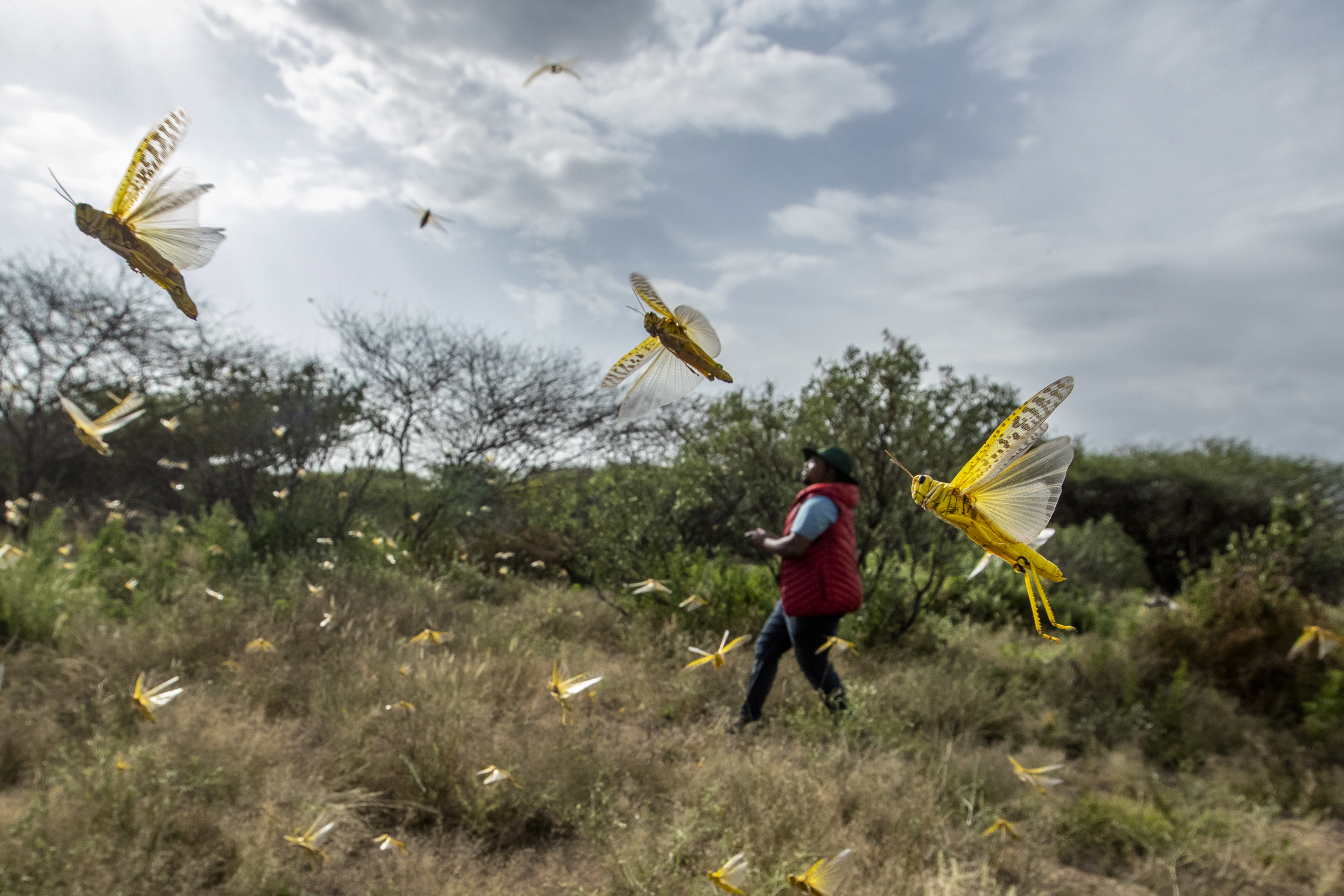
In this photo taken Saturday, Feb. 1, 2020, desert locusts jump up from the ground and fly away as a cameraman walks past, in Nasuulu Conservancy, northern Kenya. As locusts by the billions descend on parts of Kenya in the worst outbreak in 70 years, small planes are flying low over affected areas to spray pesticides in what experts call the only effective control. (AP Photo/Ben Curtis). Rwanda declared its readiness to fight locusts if they ever attack Rwanda
Rwanda Agriculture Board (RAB) and Nyagatare district authorities have quelled fears that locusts could have arrived in Rwanda after a group of insects looking like the deadly locusts were spotted in the Eastern Province district of Nyagatare.
The United Nations has warned that the locust invasion could turn into a major catastrophe for the Horn of African and Eastern African region as well as the Middle East if not managed ahead of the forthcoming rains starting March through April.
On Tuesday, photos of locust-like insects suspected to be crickets were seen in the Karama and Musheri Sectors in Nyagatare district, sending fears that the rampaging locusts which have invaded Uganda, Kenya and parts of Tanzania have entered Rwanda.
A RAB assessment report however revealed that the insects which were reported by residents of Rwubuzizi village, Akabuga cell, which were in total numbering up to 50 were not locusts but rather crickets.
“A Joint team comprised of RAB and district staff which went to the fields where the insects were reported confirmed that these are just crickets, not locusts, based on their features,” the report seen by KT Press reads.
“Residents of the two sectors have been urged to be calm. They were briefed about locust invasions and their characteristics and also urged to be vigilant and report any unusual insects in their vicinity,” it adds.
The Mayor of Nyagatare district David Claudian Mushabe on Tuesday told Kigali Today that the spotted insects were not locusts, dismissing circulating rumours on social media.
“These were about 50 insects which were seen in cassava, maize and on pumpkin stems but they were not damaging the plants nor were they flying like locusts. As soon as the reports came in, we went to the areas with a team from RAB,”
“They assessed the insects and found that they are not locusts but they were also immediately sprayed and killed,” he explained.
Mushabe said that citizens were urged to stay calm and on the lookout in case of any outbreak. Rwanda remains on the alert to avert any possible invasion of dessert locusts which have been reported in Northern Uganda.
Swarms of the deadly desert locusts entered Uganda on Sunday through the north eastern district of Amudat District, located in Karamoja region.
The invasion of the locusts which has have ravaged northern parts of Kenya has caused panic in the region, leading the fears that they could spread further to Rwanda and other parts of the great lakes, ravaging crops and vegetation.
Dr. Charles Bucagu, the RAB Deputy Director General in charge of Agriculture Research and Technology Transfer, told KT Press earlier this week that different institutions are mobilising in readiness for a possible invasion.
UN warning
The UN on Tuesday warned that the infestation in Kenya is the worst in 70 years, while Somalia and Ethiopia are experiencing their worst outbreaks in 25 years, putting crop production, food security and millions of lives at risk.
“In this region where there is so much suffering and so much vulnerability and fragility, we simply cannot afford another major shock. And that’s why we need to act quickly,” Mark Lowcock told ambassadors, during a briefing at UN Headquarters.
“We do have a chance to nip this problem in the bud, but that’s not what we’re doing at the moment. We’re running out of time,” he said.
Locusts remain the world’s oldest and most destructive migratory pest. An average swarm, which contains up to 40 million insects, can travel up to 150 km in a single day and can devour enough food to feed 34 million people within that time.
The UN said the current infestation is threatening food security in Kenya and the region.

